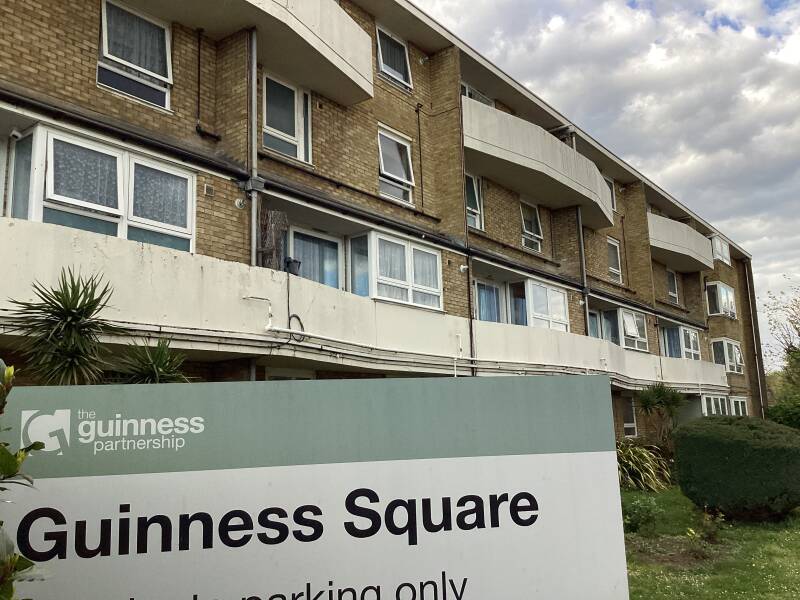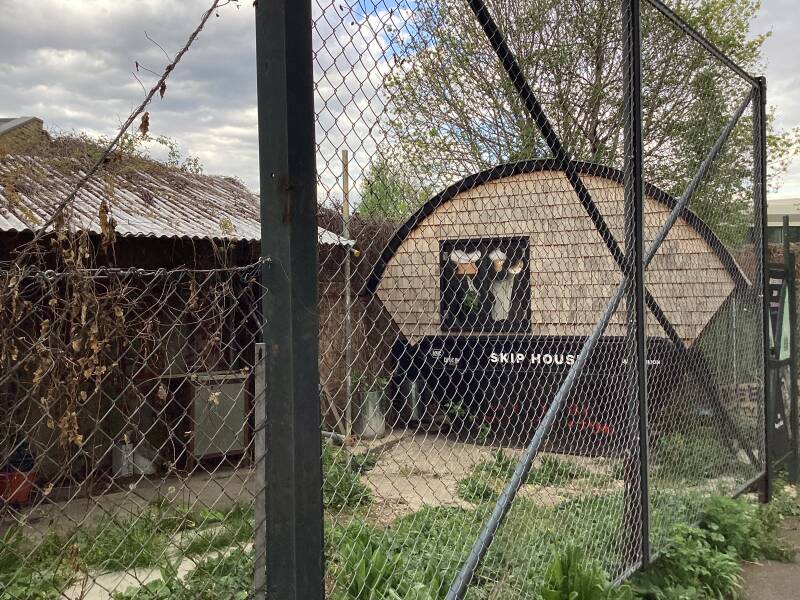
ROTHERHITHE to BERMONDSEY
After ST.MARY’S Church, and the village
From market gardens to SOUTWARK PARK
Beside the park
MILLSTREAM HOUSE
LONDON REMEMBERS says: The plaque explains the presence here of these bits of the Houses of Parliament with a connection between the two buildings - they were both damaged in WW2 air raids!
Nobody knows with precision why this governmental bomb debris finished up on a block of flats in Bermondsey.
It's most likely that the gargoyle and stone became available on 10/11 May 1941 when the House of Commons was badly damaged. See this House of Commons page for details of other liberated lumps of Parliamentary stone that found other homes.
Southwark Park is Grade II listed, covers 26 hectares and opened to the public on the 19thJune 1869. Its design was based on an original map, produced by the Superintendent Architect, Mr Vulliamy, and Alexander McKenzie. The original intention was for part of the park to be used as building plots, but the Vestry of Bermondsey opposed this.
In 1884 a bandstand which was acquired from the Great Exhibition {actually the International Exhibition of 1862} in South Kensington was placed in the Park.
By 1885 substantial changes to the layout had occurred including the addition of the lake. In 1908 the lake was enlarged and adapted for boating. The English Rose Garden replaced island bedding in 1934 and was commissioned by Dr Salter to create a peaceful retreat for people to relax. In 1942 it was renamed the Ada Salter Garden in memory of his wife. In 1872 the carriage drive was reduced in width when the building plans were eventually shelved. The original carriage drive leading from Jamaica Gate now divides the park.
1862 GREAT INTERNATIONAL EXHIBITION BANDSTAND
Francis Fowke designed the buildings for the 1862 International Exhibition in South Kensington and also some of the items in the neighbouring RHS Garden such as the conservatory and two band houses, as they were originally called. These cast-iron bandstands were the first erected in this country. The design was inspired by Indo-Islamic architecture and the roof, a wooden dome covered in zinc, wasn’t just to provide rain cover, it also acting as a sounding board to project the music out to the audience.
In 1888 when the RHS Garden vacated the South Ken site the LCC bought both of the bandstands. One was erected at Peckham Rye (see Arts and Culture for a photo) and was opened by the Earl of Meath on 13 July 1889. That same year some LCC minutes note that a previous smaller bandstand in Southwark Park was to be moved to Plumstead Common and replaced with one of the South Kensington bandstands. Maps suggest that a bandstand survived in Southwark Park until at least 1954 but had gone by 1968. Historic England says it was removed by 1947. It’s possibly that the ironwork was removed in WW2, along with many railings, for supposed reuse as armaments. In 1999 the bandstand was reconstructed using the original detailed drawings as part of a Heritage Lottery Funded restoration of the Park.
JSTOR (Garden History Vol. 29, No. 2 (Winter, 2001), pp. 214-216) has a good image showing one of the bandstands in the RHS Gardens at the International Exhibition in 1862.
Note: an LCC minute of 1890 refers to a bandstand being erected on Clapham Common and that has often been taken (by British History Online no less) to refer to one of the Fowke bandstands. But it seems it is a modified replica. Arts and Culture have a photo if you wish to compare and contrast.
JABEZ WEST FOUNTAIN
This fountain was erected in memory of the temperance advocate Jabez West and formally unveiled on 3rd April 1885. West (6th 1810 – 1884) was a blacksmith’s son from Princes Risborough, who came to Bermondsey in the 1830s. He worked in the leather trade but became best known in the area for devoting his time to political reform and the temperance movement. He also campaigned for Southwark Park. After his death, the Metropolitan Board of Works took the unusual step of agreeing to this memorial for a working-class man. The fountain is made of polished grey granite at an original cost of £120, which was paid for by public subscription.
CARYATIDS from the destroyed TOWN HALL
Designed and constructed {* see our note below} by Henry Poole RA and opened on April 28th 1897, the Town Hall was sited on the corner of Neptune Street and Lower Road, with the rear of the building on Moodkee Street. These caryatides originally flanked the main entrance of the old Rotherhithe Town Hall, which in 1905 was converted into a library. The building was severely damaged by the German air raids of the second world war and subsequently demolished. the caryatides remained on their original site until 1974 when they were relocated within the Heygate Estate just off the New Kent Road. In 2009 the caryatides were removed when demolition of the estate commenced, and located back here in Rotherhithe in 2011.
Caryatides are a Greek architectural support in the form of a female figure which replaces the column or pillar. The significant differences between the two caryatides is one is detailed with oak and the other laurel. Oak is often seen as an emblem of virtue, strength, resiliency, longevity and rebirth. Laurel is a token of peace and quiet but also a symbol of triumph and fame.
* Note: Poole was not an architect, he designed and created these caryatides, not the building, which was the work of Murray and Foster.
ADA SALTER ENGLISH GARDEN & TREE
An information board in the southern corner of the garden provides:
Southwark Park - The Ada Salter Garden (1936)
Born in Rauds, Northamptonshire in 1867, Ada Brown moved to the Capital to join the West London Mission. In 1897 she transferred to the Bermondsey Settlement in Farncombe Street to run a Girls' Club where she met and later married Dr. Alfred Salter in 1900.
Living above Dr Salter's Surgery on the corner of Keeton's Road and Jamaica Road, the couple set about their programme of far reaching social reform.
Largely overshadowed by Alfred, a local councillor and later MP for West Bermondsey, Ada too followed a political career, becoming one of the country's first women councillors in 1909, and Britain's first woman Labour mayor in 1922.
By the early 1930s, the Bermondsey Beautification Committee (started the previous decade by the Salters) had made an impact; hundreds of trees now lined the streets of Bermondsey and small plots of once derelict land were a rainbow of colour. However there was one place, although very green, that was lacking in colour - Southwark Park, which was owned and administered by the London County Council (LCC).
After many years of petitioning the LCC, it took a change of power in 1934 to obtain the funding necessary for Ada's "pet project", an Old English Garden. Created by Col. J. J. Sexby, Superintendent of LCCs Parks, the garden was opened in the autumn of 1936; unfortunately Ada was too ill to attend this opening.
Ada Salter died on December 5th 1942. In July 1943 the LCC decided that the garden should be renamed The Ada Salter Garden. A wall plaque placed at the back of the once roofed rose-covered central pergola read "This garden is named after Mrs Ada Salter, a member of the Parks Committee of the LCC from 1925 to 1941, in commemoration of her devoted service to the people of Bermondsey".
Bermondsey Borough Council also paid tribute to Ada's life and work by planting a Tree of Heaven (Ailanthus Glandulosa); this was her favourite tree and had a symbolic meaning to her Quaker beliefs. This tree and memorial stone can still be seen today close by the eastern entrance to the garden. Many of the plants were replaced as part of the Lottery project 2001/2 Funding from the HLF.
”The Guv’nor”
Bobby Abel, "The Guv'nor", 1857 - 1936, one of England's finest ever cricketers, learned his cricket in Southwark Park.
CORONATION CHESTNUT TREE
This Chestnut tree was planted by the London County Council to commemorate the Coronation of Her Majesty Queen Elizabeth II on 2nd June 1953.
This plaque and new railings are provided by Southwark Council as a further dedication and celebration of the Coronation of Her Majesty Queen Elizabeth II.
Unveiled by Mrs Jenny Bianco, Representative Deputy Lieutenant for Southwark on 19th June 2013.
PAVILION CAFÉ
LAKE and DILSTON ART GALLERIES

ATTENTION, ATTENTION: You can divert now towards the Southern tip of the Bermondsey Beer “Mile” (only a mile?)
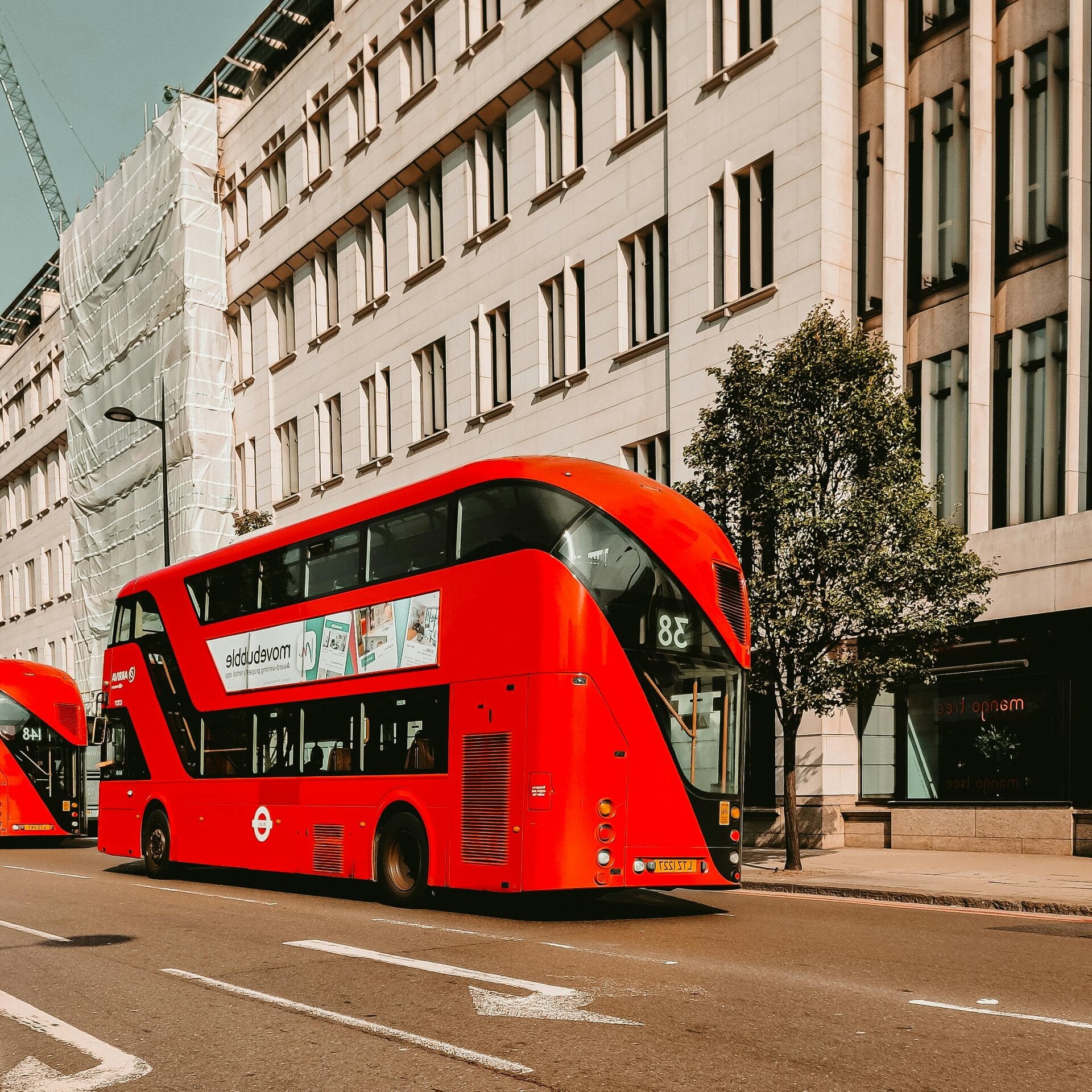
Southwark Park Road
THE STANLEY ARMS P.H.
https://deserter.co.uk/2015/10/bermondsey-tides/ : interesting site dealing with this pub and with Bermondsey
CITY HOPE, Evangelical Church


BISCUIT TOWN
THE BISCUIT FACTORY. Former PEEK FREAN BISCUITS FACTORY

THE BLUE

Welcome to The Blue…the Blue Anchor?. Anchor?. An anchorite
Anchorite' is derived from the Greek anakhorein, to retire or retreat, since anchorites and anchoresses had sequestered themselves from the world to contemplate God thereby, they hoped, assuring their salvation.
THE BLUE ANCHOR
The Blue Anchor pub built in 1876. The area known as The Blue was probably named after a previous tavern of the same name, probably on this site.
The Old Bank pub is situated on the corner of the square and Southwark Park Road. The flags represent support for England and Millwall Football Club whose ground The Den is close to The Blue.
A Pie and mash shop on Southwark Park Road in The Blue. Pie, mash and eels is a traditional dish in the East End and South East London.
THE BERMONDSEY LION
This representation of the Bermondsey Lion was created by Kevin Boys for Southwark Council. It was unveiled on 16 July 2011.
Blue Anchor Lane
Lucey Way
Linsey St.
ST.JAMES’S OF BERMONDSEY P.H.
THE BERMONDSEY PROJECT

Site of SPA ROAD STATION, London's first railway terminus.
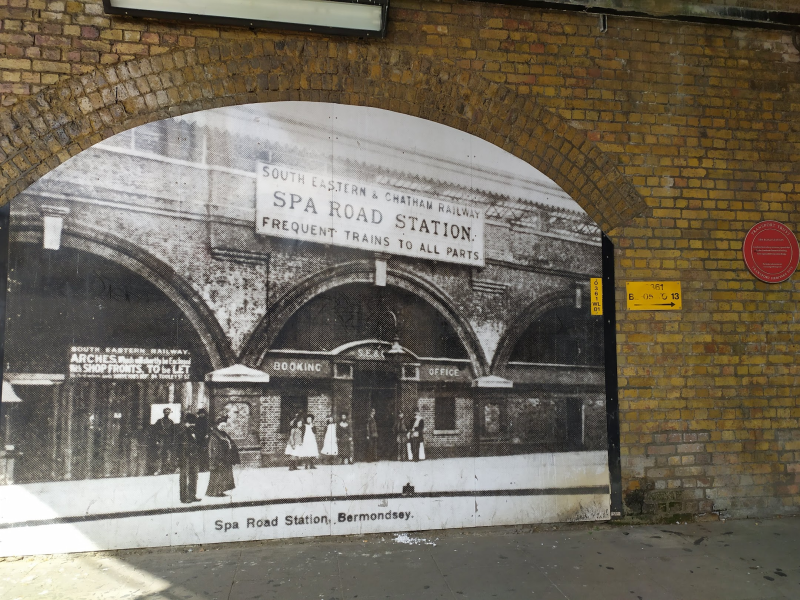
A terminus of the London and Greenwich Railway, London's first railway. The original station was badly located and had a very narrow platform. Passengers were supposed to queue on the steps outside, but actually waited on the track itself! When London Bridge station opened, usage of the old station declined and it closed in 1838. The viaduct on which it had stood was eventually widened and with increased public demand, a new station opened in 1842. In 1867 it was relocated further along the viaduct. It was closed as a wartime security measure, and never re-opened.





Railway Mania
By the 1860s the construction of railways in London was extensive. One of Anthony Trollope’s characters is “… having to meet a synod of contractors, surveyors, and engineers, to discuss which of the remaining thoroughfares of London should not be knocked down by the coming of the railways…” (‘The Claverings’, 1866-7).
First passenger train in the UK
The first public railway to carry passengers in the UK was the Swansea and Mumbles Railway, which opened in 1807, using horse-drawn carriages. The first steam-powered passenger railway was the Stockton and Darlington Railway, which opened in 1825.
The Liverpool and Manchester Railway was the first inter-city railway in the world. It opened on September 15, 1830. It used steam locomotives to transport both passengers and goods.
Transport Minister Huskisson

William Huskisson becomes the first widely reported passenger train death. During the ceremonial opening of the Liverpool and Manchester Railway, while standing on the track at Parkside, he is struck and fatally injured by the locomotive Rocket. (Locomotives did not yet have whistles.)
The Rocket locomotive was built in 1829 by Robert Stephenson & Co. at the Forth Street Works in Newcastle upon Tyne, England. It was designed by Robert Stephenson and became famous for winning the Rainhill Trials, a competition to determine the best locomotive for the Liverpool and Manchester Railway
ABBEY ST. and SPA ROAD BRIDGES

A greatly enlarged etching of the bridge in 1835 has been placed on the wall opposite the plaque. It shows a much shorter tunnel with only four pairs of pillars between stone piers whereas now there are twelve, plus a section (shown in our photo) with none. We take that to mean that tracks have been added to the railway system above and that initially the tunnel was extended, pillars and all, but on the last occasion it was decided that was just too expensive. Note: The etching is labelled Neckinger Road which was the name of this street until 1912.
There are similar colonnades of blue pillars at the nearby Spa Road bridge and at Holyrood Street but at this last the columns are not fluted.
ST.JAMES’S Church
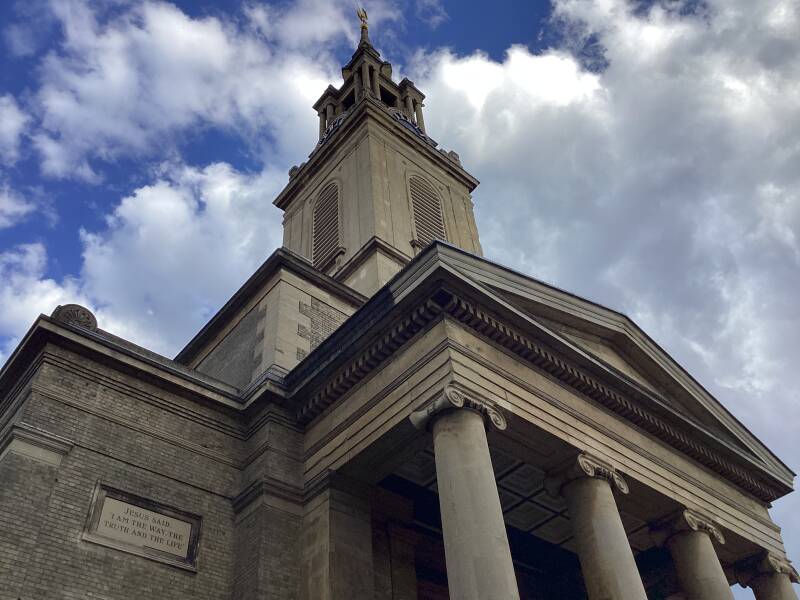


At the end of the 18th century and start of the 19th, the population of Bermondsey was expanding rapidly and the area needed a church to serve those moving into the area.
St. James’ is one of the so called Commissioners Churches as it was a result of the Church Building Act of 1818 when Parliament voted money for the construction of new churches.
A group of local churchman purchased the land for the church and were given a grant by the Commissioners of the fund provided by Parliament for the construction of the church.
Construction of the church was delayed whilst additional funds were raised to build both a tower and a spire. This was achieved by building a crypt under the church were space was sold for burials, thereby allowing the money to be raised for construction of the tower, topped by a spire which we see today.
John Savage was the architect, the first stone was laid in February 1827 and the church was consecrated one year later in May 1829.
The famous slide
Nearby


L.U. Station: Memorial to DR.SALTER

THE GREGORIAN P.H.
Shops and eateries (Jamaica Road)
Old Jamaica Road
Frean St.
Marine St.
Site of a new access to the SPA ROAD station
After the demolition of the old stairway and the building a new internal one from an arch in West Street, now known as Marine Street. In 1867 the station was relocated 180 metres along the viaduct toward the east, with an entrance sitting on Priter Road.
Enid Street (and Druid Street): the Bermondsey Beer “Mile”
Council Estate
Neckinger (street)
The course of a river… the Neckinger
SPA GARDENS
Hang on…a Spa, in Bermondsey?
A fantastic history page by…
In 1770, a man named Thomas Keyse discovered a natural spring on land he owned by what is now known as Spa Road. As a result of his discovery Bermondsey became a spa town. In the 18th century people believed that drinking mineral water was good for your health and many doctors prescribed water from the Bermondsey Spa to their patents. As a result, Bermondsey boomed and in the late 18th century many large houses were built in the area. However, the boom was short lived and the spa closed in 1804. Today Bermondsey Spa Gardens is not far from the site of the 18th century Bermondsey Spa Pleasure Gardens originally developed in 1784 to rival the popular Vauxhall Gardens at a cost of £4,000. Picture courtesy of exploringsouthwark.co.uk
The gardens were situated south of Spa Road, in a rural area with streams and ditches, offering a bucolic setting
Former TOWN HALL annexe
Site of Town Hall (see the pillars remaining)
Former PUBLIC LIBRARY, now BUDDHIST CENTRE
ALASKA HOUSE.Former fur factory
Page Walk
THE VICTORIA P.H.

Site of BRICKLAYERS ARMS, goods railway depot and station
Stables and houses
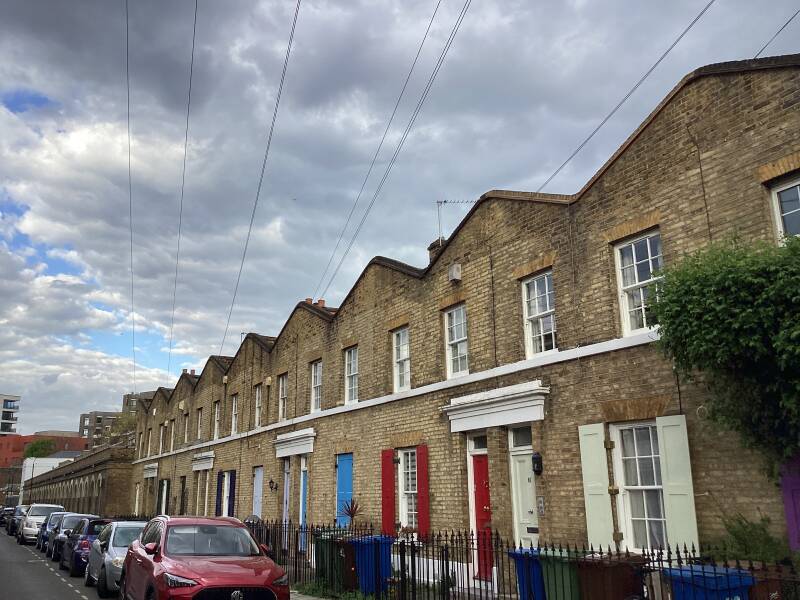

Social housing
